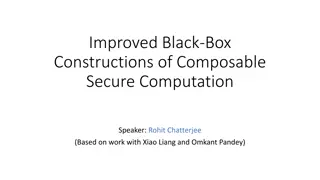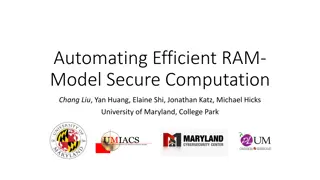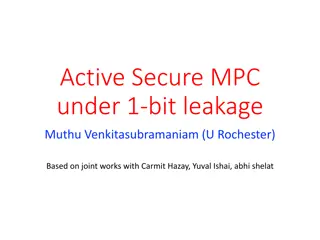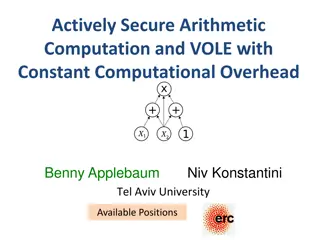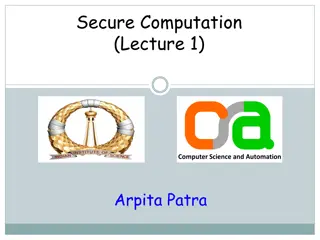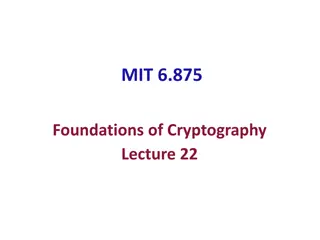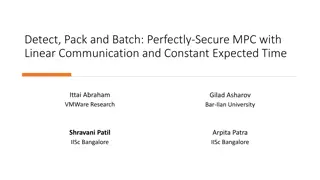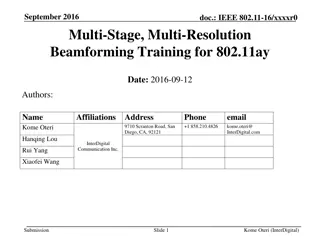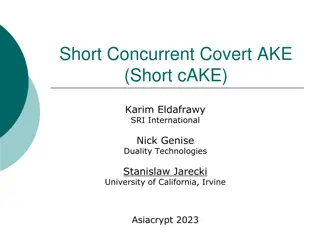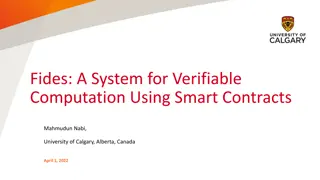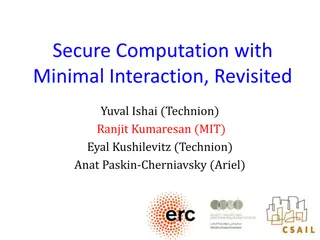Efficient Multi-Party Computation Techniques
Explore the innovative approaches to Multi-Party Computation (MPC) such as MPC via Fully Homomorphic Encryption (FHE) and Multi-Key FHE. The focus is on minimizing round complexity and achieving secure distributed computations. Learn about key concepts, protocols, and advancements in the realm of MPC.
Download Presentation

Please find below an Image/Link to download the presentation.
The content on the website is provided AS IS for your information and personal use only. It may not be sold, licensed, or shared on other websites without obtaining consent from the author.If you encounter any issues during the download, it is possible that the publisher has removed the file from their server.
You are allowed to download the files provided on this website for personal or commercial use, subject to the condition that they are used lawfully. All files are the property of their respective owners.
The content on the website is provided AS IS for your information and personal use only. It may not be sold, licensed, or shared on other websites without obtaining consent from the author.
E N D
Presentation Transcript
Two Round MPC Two Round MPC via Multi via Multi- -Key FHE Key FHE Daniel Wichs (Northeastern University) Joint work with Pratyay Mukherjee
Multi-Party Computation Arbitrary number of corruptions. f(x1, ,xn) Goal: Correctness: Everyone computes f(x1, ,xn) Security: Nothing else revealed
Motivating Questions Construct MPC with minimal round complexity. Construct MPC directly using FHE techniques.
Round Complexity Ideally: 2 is best we can hope for Know: 4 from OT [BMR90,KOS03,AIK05, ], 3 from LWE [AJLTVW12], 2 with iO [GGHR14]. This talk: 2 from LWE. * Results in CRS model, needed for malicious security. Results require NIZKs for malicious security.
MPC from FHE Parties run distributed key generation of FHE scheme: agree on a common public key pk, each party gets a secret-share of sk. Each party i broadcasts Encpk(xi). The parties run homomorphic evaluation to get Encpk( f(x1, ,xn) ). Parties run a distributed decryption to recover y = f(x1, ,xn). For the FHE schemes of [BV11,BGV12] we can directly construct distributed key generation and decryption in 1 round each. Yields a 3 round MPC [AJLTVW12].
MPC from Multi-Key FHE Each party i chooses pki, ski broadcasts Encpki(xi). All parties run a multi-key FHE eval to get Encpk1, ,pkn( f(x1, ,xn) ). Parties run a distributed decryption to recover y = f(x1, ,xn). Multi-key FHE defined by [Lopez Alt-Tromer-Vaikuntanathan 12], Construct from NTRU. Distributed decryption via generic MPC. Recent: multi-key FHE from LWE [Clear-McGoldrick 14]. This work: Simplify multi-key FHE from LWE Show 1 round distributed decryption, get 2 round MPC.
Gentry-Sahai-Waters FHE Multi-Key FHE (variant of Clear-McGoldrick) 2-round MPC
The GSW FHE: Key Generation m B Public Key: A = ? ? n ? b = sB+e ? Secret Key: t = (-s,1) ? Remember:tA 0
The GSW FHE: Encryption Encpk(x): encryption of bit x under pk=A C = AR + xG R {0,1}m x m is random G ? ? ?is a public gadget matrix Remember: tC xtG
Gadget Matrix G G [Micciancio-Peikert 12] ? ? Gadget matrix G ? There is an efficiently computable function G-1( ) such that: G-1: ? for all C : GG-1(C) = C ? ? 0,1? ? Implementation: G-1is the bit decomp function Gconsists of powers-of-2
The GSW FHE: Evaluation Assume C1, C2encrypt bits x1, x2 respectively: tCi xitG Addition:C+ = C1 + C2 tC+= t(C1 + C2) (x1 + x2)tG Multiplication:Cx = C1 G-1( C2 ) tCx= (x1tG + e) G-1( C2 ) x1t C2 x1x2tG
Multi-Key Version of GSW Scenario: parties 1, ,N have independent GSW key pairs. Party i has secret ti ? Expanded secret key t* = (t1, ,tN) ? ?. ??. Goal: Convert party i ctext into expanded multi-key ctext. Party i ctext is C ? Expanded ctext is C* ? ? ? : tiC xtiG. ?? ??: t*C* x t*G* ? 0 for expanded gadget matrix G* = . 0 ? Can perform homomorphic GSW operations on expanded ciphertexts. Let s do this for N=2 parties , everything extends naturally.
Ciphertext Expansion B B A1 = A2 = b1 = s1B+e1 b2 = s2B+e2 t1 = (-s1, 1) : t1 A1 0 t2 = (-s2, 1) : t2 A2 0 Have two key pairs (A1, t1), (A2, t2). Party 1 encryption of x is: C = A1R + xGplus helper info (TBD). t1 C xt1G. t2C = t2(A1R + xG) = (-s2B + b1)R + xt2G (b1 - b2)R + xt2G Expanded ciphertext: C* = ? ? Then: t*C* = (t1, t2)C* = [t1C, t1D + t2C] [xt1G, xt2G] = x t* G* Use helper info to find D such that t1D (b2 - b1)R ? ? where D is TBD.
Ciphertext Expansion B B A1 = A2 = b1 = s1B+e1 b2 = s2B+e2 t1 = (-s1, 1) : t1 A1 0 t2 = (-s2, 1) : t2 A2 0 Goal: Given (C = A1R + xG, helper info) find D s.t. t1D (b2 - b1)R. Solution: Helper info = GSW encryptions of each R[i,j] under A1 Ci,j : t1Ci,j R[i,j] t1 G Given b1, b2can homomorphically compute a matrix D : t1D (b2 - b1)R
One-Round Distributed Decryption ??. Expanded secret key t* = (t1, ,tN) ? Expanded ctext is C* ? Sanitized ctext: c = C*G*-1(w) : w = (0, ,0,[q/2])T ? <ti,ci> = <t*,c> = t*C*G*-1(w) x <t*,w> x[q/2] ?? ??: t*C* x t*G* ??. Distributed decryption: each party outputs partial decryption pi = <ti,ci> + e with error e. Error e drowns out the error contained in c. Security: Can simulate one party s partial decryption pi given x and all other keys {tj : j i}. c1 c = nN cN
Putting it all together Each party i chooses pki, ski broadcasts ci = Encpki(xi). All parties run a multi-key FHE eval to get c* = Encpk1, ,pkn( f(x1, ,xn) ). Parties run a distributed decryption to recover y = f(x1, ,xn). Secure for all-but-one corruption. Proving security for arbitrary corruptions requires some more work. Need NIZKs for malicious security (but no coin flipping). Questions: Can we get rid of the CRS in honest-but-curious setting? Can we get 2 or even 3 rounds under different/weaker assumptions?



